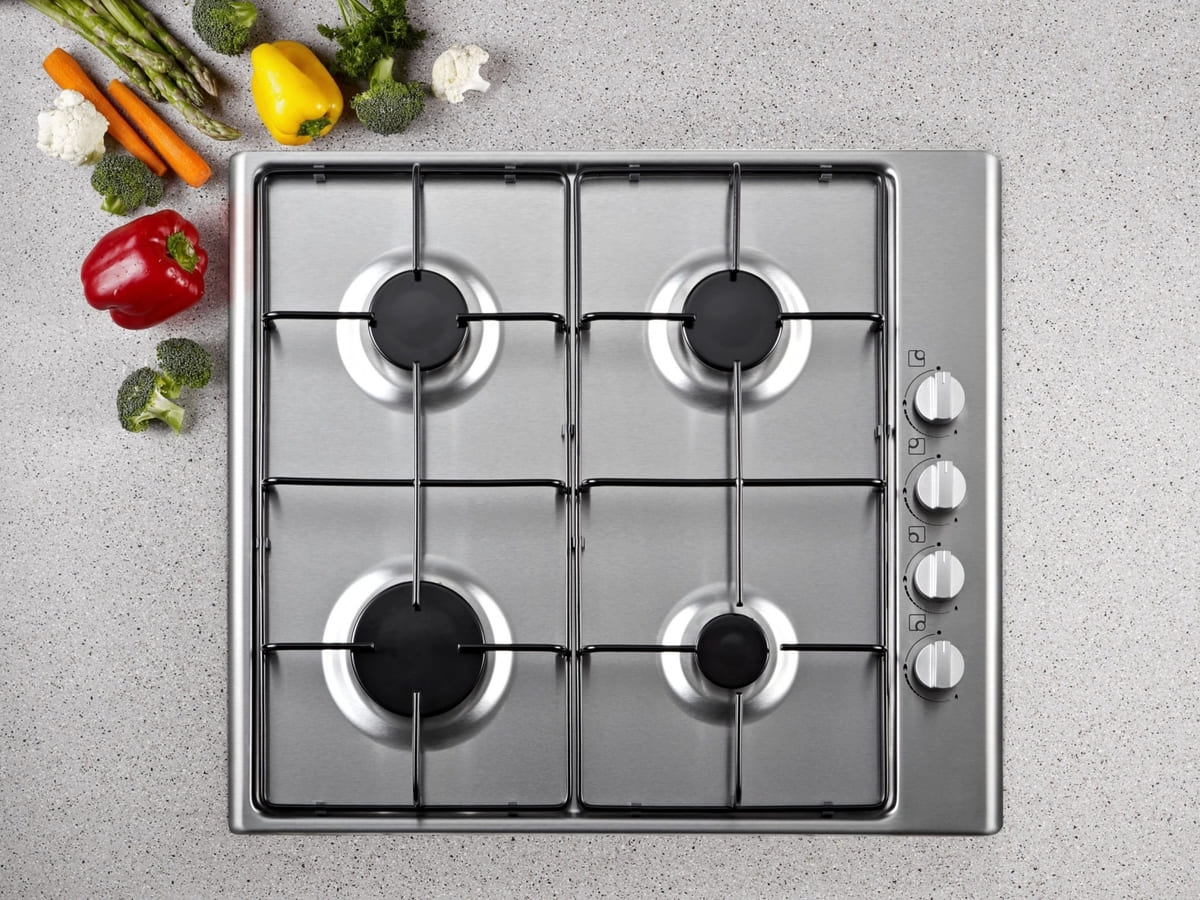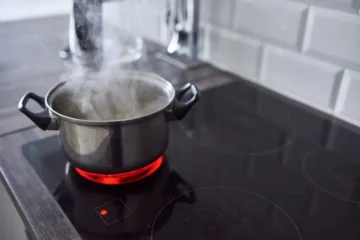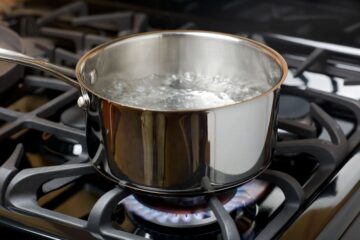When it comes to using an electric stove, you may have come across the letters “PF” on the display panel. These letters can be confusing, especially if you’re not sure what they mean. In short, “PF” stands for “Power Failure,” which means that the stove is not receiving adequate power to function properly.
The “PF” code can appear on the display panel for various reasons, such as a power outage, a tripped circuit breaker, or a damaged power cord. When this happens, the stove may not be able to perform certain functions, such as setting the clock or powering the heating elements. It’s important to address the issue promptly to prevent any damage to the stove and ensure that it functions properly in the future.
What is PF on a Stove?
PF on a stove stands for “Power Failure.” It is a code that appears on the display panel of an electric stove to indicate that there has been a power outage or disruption. This feature is designed to protect the stove’s electronic components from power surges, which can cause damage or malfunction.
When the power goes out, the stove will automatically shut off to prevent any food from burning or overcooking. Once the power is restored, the stove should turn back on and resume normal operation. However, if the PF code continues to appear on the display panel, it may indicate a problem with the stove that needs to be addressed.
There are several reasons why a stove may display the PF code, including:
- Power outage or disruption
- Loose or damaged wiring
- Faulty control board
- Defective heating element
If the PF code persists, it is recommended to consult the stove’s user manual or contact a professional technician for assistance. It is not recommended to attempt to repair the stove oneself, as it may result in further damage or injury.
In summary, PF on a stove means “Power Failure.” It is a safety feature that protects the stove’s electronic components from power surges. If the code persists, it may indicate a problem that needs to be addressed by a professional technician.
How Does PF Work?
PF stands for “Power Failure,” and it is a feature in some stoves that alerts the user when there is a power cut. When the power goes out, the stove will automatically shut off, preventing food from burning or overcooking.
PF is not a failure mode, but rather a feature that is designed to prevent food from spoiling or getting cold due to the power outage. The stove will display the PF code on its control panel to let the user know that there has been a power failure.
To reset the stove after a power failure, the user needs to turn off the power to the stove and then turn it back on. This will reset the stove’s control panel and allow the user to use the stove again.
It is important to note that the PF code may also appear if the stove is not receiving adequate power. This can prevent it from performing certain functions, such as setting the clock or powering the heating elements. In this case, the user should check the stove’s power source and make sure that it is receiving adequate power.
Benefits of Using PF on a Stove
PF stands for “Power Failure” and is a feature found on many modern stoves. This feature is designed to protect the stove’s electronic components from power surges and prevent food spoilage. In this section, we will discuss the benefits of using PF on a stove.
Prevents Food Spoilage
One of the main benefits of using PF on a stove is that it helps prevent food spoilage. If a power failure occurs while food is cooking, and the stove is not equipped with a PF feature, it could result in food being overcooked or burned, which can be a health hazard. PF ensures that the stove will shut off automatically during a power outage, preventing the food from being overcooked or burned.
Protects Electronic Components
Another benefit of using PF on a stove is that it protects the stove’s electronic components from power surges. Power surges can cause damage or malfunction to the stove’s electronic components, which can be expensive to repair or replace. PF ensures that the stove’s electronic components are protected during power surges, which can extend the lifespan of the stove.
Easy to Use
Using PF on a stove is easy. Once the stove is plugged in, the PF feature is automatically activated. If a power failure occurs, the stove will shut off automatically, and an indicator light will appear on the stove’s control panel. Once power is restored, the stove will resume normal operation.
Cost-Effective
Using PF on a stove is a cost-effective way to protect your stove’s electronic components from power surges and prevent food spoilage. It is a simple feature that can extend the lifespan of your stove and save you money in the long run.
In conclusion, using PF on a stove has several benefits, including preventing food spoilage, protecting electronic components, ease of use, and cost-effectiveness. It is a simple feature that can make a big difference in the lifespan and performance of your stove.
Different Types of PF Stoves
When it comes to stoves, PF stands for Power Failure. This feature is designed to alert the user when there is a power cut. In the event of a power failure, the stove will automatically shut off, preventing food from burning or overcooking. There are different types of PF stoves available in the market, which are discussed below.
Electric PF Stoves
Electric stoves are powered by electricity and do not require a gas line connection. These stoves are available in different sizes and styles, including freestanding, slide-in, and drop-in. The electric PF stoves have a digital display that shows the time, temperature, and other settings. When the power goes out, the stove will display the PF code to indicate the power failure. The stove will automatically shut off, preventing food from burning or overcooking.
Gas PF Stoves
Gas stoves are powered by natural gas or propane and require a gas line connection. These stoves are available in different sizes and styles, including freestanding, slide-in, and drop-in. The gas PF stoves have a digital display that shows the time, temperature, and other settings. When the power goes out, the stove will display the PF code to indicate the power failure. The stove will automatically shut off, preventing food from burning or overcooking.
Gas stoves are available in different burner configurations, including four burners, five burners, and six burners. The burners are available in different sizes and BTUs, which affect the cooking performance. The higher the BTUs, the faster the burner will heat up the pot or pan. The gas stoves also have different features, including self-cleaning, convection, and griddle.
How to Use PF on Your Stove?
PF code on a stove stands for “power failure.” It means that the stove is not receiving adequate power, which can prevent it from performing certain functions, such as setting the clock or powering the heating elements. However, the PF code can also be used as a feature on some stoves.
When the PF code is used as a feature, it can be programmed to turn off the stove after a certain amount of time has passed. This can be useful for those who often forget to turn off their stove after cooking. To use the PF feature on your stove, follow these steps:
- Press the “Clock” button on your stove.
- Press the “Start” button to enter the time you want the stove to turn off.
- Press the “PF” button to activate the feature.
- The stove will turn off automatically at the programmed time.
It is important to note that not all stoves have the PF feature. If you are unsure if your stove has this feature, refer to the user manual or contact the manufacturer for assistance.
If you encounter the PF code on your stove and it is not a programmed feature, it may indicate a power failure. In this case, refer to the user manual or contact a professional for assistance with troubleshooting and resolving the issue.
Cleaning and Maintenance of PF Stoves
PF stoves are designed to alert the user when there is a power cut. This feature is designed to prevent food from spoiling or getting cold due to the power outage. However, like all appliances, PF stoves require regular cleaning and maintenance to ensure they function properly.
To keep your PF stove in good working order, it is important to clean it regularly. Here are some tips on how to clean and maintain your PF stove:
- Clean the surface regularly: Use a damp cloth to wipe down the surface of the stove after each use. This will help prevent grease and grime from building up.
- Clean the burners: Remove the burners from the stove and soak them in warm, soapy water for a few minutes. Use a soft brush to scrub away any debris, then rinse the burners thoroughly and dry them with a clean cloth.
- Clean the oven: If your PF stove has an oven, it is important to clean it regularly. Use a commercial oven cleaner or make your own by mixing baking soda and water into a paste. Apply the paste to the interior of the oven and let it sit for several hours, then wipe it away with a damp cloth.
- Check the power supply: If your PF stove is displaying the PF code, it may be due to a power outage. Check the power supply to ensure that the stove is receiving adequate power. If the power supply is not the issue, you may need to call a professional to diagnose and repair the problem.
- Schedule regular maintenance: It is important to schedule regular maintenance for your PF stove to ensure that it functions properly. This may include replacing worn parts, cleaning the interior of the stove, and checking the power supply.
Conclusion
In conclusion, when you see PF on your stove, it means that the appliance has detected a power outage or disruption. This function is designed to protect the stove’s electronic components from power surges, which can cause damage or malfunction. The PF code on an electric stove stands for “power failure.” It means that your stove is not receiving adequate power, which can prevent it from performing certain functions, such as setting the clock or powering the heating elements.
If you encounter the PF code on your stove, you can try resetting the appliance by unplugging it and plugging it back in. This may clear the code and allow you to resume cooking. If the code persists, it may indicate a more serious problem with the appliance that requires professional repair.



